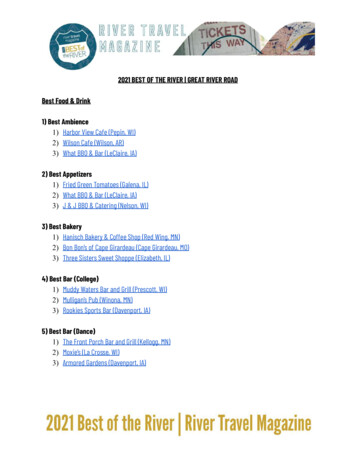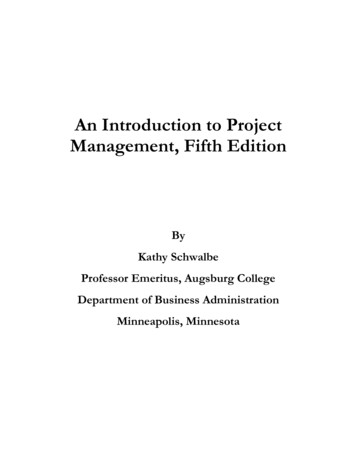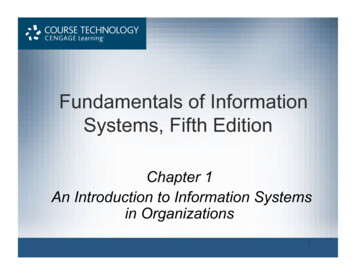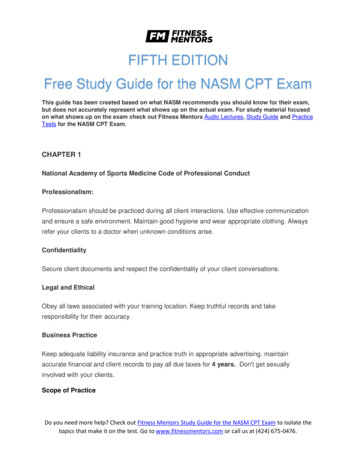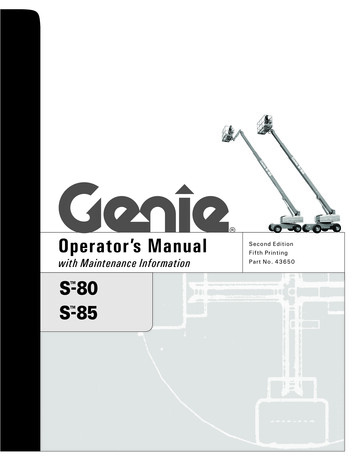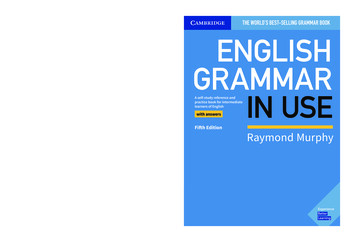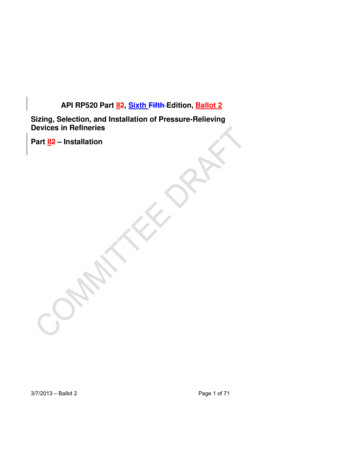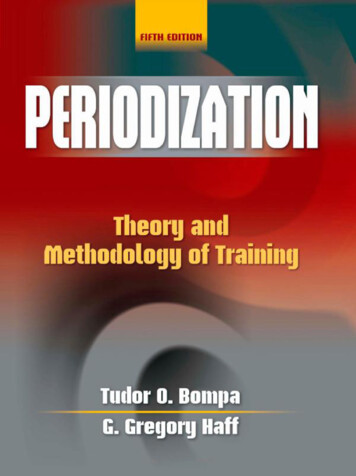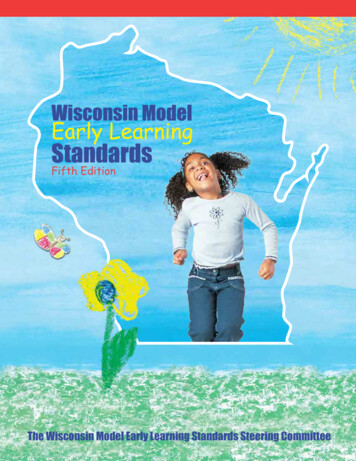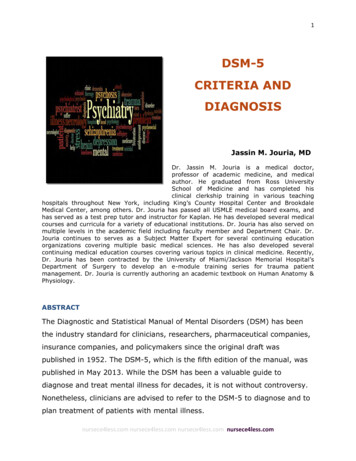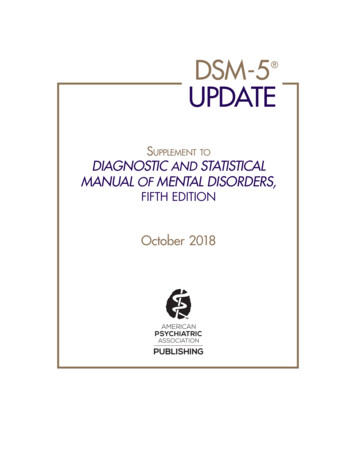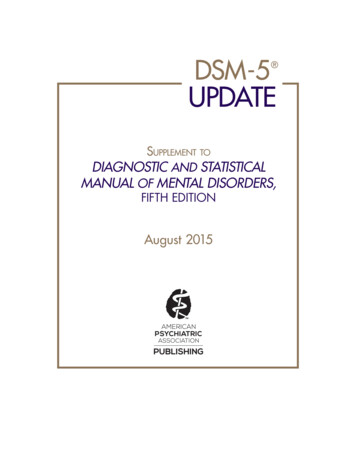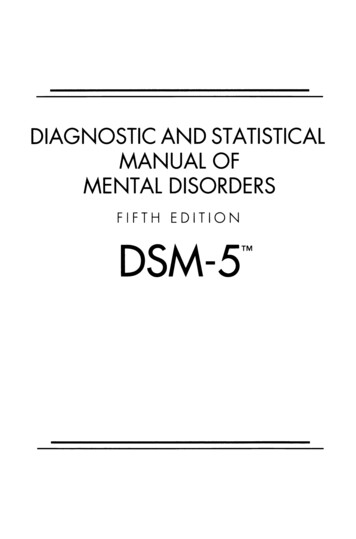
Transcription
DIAGNOSTIC AND STATISTICALMANUAL OFMENTAL DISORDERSFI FTHEDITIONDSM-5TM
American Psychiatric AssociationOfficers 2012-2013P resident D ilip V. J este , M.D.P resident -E lect J effrey A. L ieberm an , M.D.T reasurer D avid F assler , M.D.S ecretary R cxser P eele , M.D.AssemblyS peaker R. Scott B enson , M.D.S peaker -E lect M elinda L. Y oung , M.D.Board of TrusteesJ effrey A kaka , M.D.C arol A. B ernstein , M.D.B rL· C row ley , M.D.A nita S. E verett , M.D.J effrey G eller , M.D., M.P.H.M c D avid G raff , M.D.'J e &A.G i eneVM.D.J udith F. K ashtan , M.D.M olly K. M c V oy , M.D.J am es E. N ininger , M.D.J ohn M. O ldham , M.D.A lan F. S chatzberg , M.D.A lik s . W idge , M.D., P h .D.E rik R. V anderlip , M.D.,M em ber - in -T raining T rustee -E lect
DIAGNOSTIC AND STATISTICALMANUAL OFMENTAL DISORDERS7FI FTHEDITIONDSM-5TMNew School Library/«44AmcriccinO svchiatricADivi«ono(AmCT»MlVhijtiKAMod tk nW ashington, DCLondon, England
Copyright 2013 American Psychiatric AssociationDSM and DSM-5 are trademarks of the American Psychiatric Association. Use of these termsis prohibited without permission of the American Psychiatric Association.ALL RIGHTS RESERVED. Unless authorized in writing by the APA, no part of this book maybe reproduced or used in a manner inconsistent with the APA's copyright. This prohibitionapphes to unauthorized uses or reproductions in any form, including electronic applications.Correspondence regarding copyright permissions should be directed to DSM Permissions,American Psychiatric Publishing, 1000 Wilson Boulevard, Suite 1825, Arlington, VA 22209 3901.Manufactured in the United States of America on acid-free paper.ISBN 978-0-89042-554-1 (Hardcover)ISBN 978-0-89042-555-8 (Paperback)American Psychiatric Association1000 Wilson BoulevardArlington, VA 22209-3901www.psych.orgThe correct citation for this book is American Psychiatric Association: Diagnostic and Statisti cal Manual of Mental Disorders, Fifth Edition. Arlington, VA, American Psychiatric Associa tion, 2013.Library of Congress Cataloging-in-Publication DataDiagnostic and statistical manual of mental disorders : DSM-5. — 5th ed.p. ; cm.DSM-5DSM-VIncludes index.ISBN 978-0-89042-554-1 (hardcover : alk. paper) — ISBN 978-0-89042-555-8 (pbk. : alk. paper)I. American Psychiatric Association. II. American Psychiatric Association. DSM-5 Task Force,m. Title: DSM-5. IV. Title: DSM-V.[DNLM: 1. Diagnostic and statistical manual of mental disorders. 5th ed. 2. Mental Disorders—classification. 3. Mental Disorders—diagnosis. WM 15]RC455.2.C4616.89Ό75—dc232013011061British Library Cataloguing in Publication DataA CIP record is available from the British Library. n Text Design—Tammy J. CordovaManufacturing—Edwards Brothers Malloy cH
ContentsDSM-5 Classification.xiiiPreface. xliSection IDSM-5 BasicsIntroduction. 5Use of the Manual.19Cautionary Statement for Forensic Use of DSM-5. 25Section IIDiagnostic Criteria and CodesNeurodevelopmental Disorders. 31Schizophrenia Spectrum and Other Psychotic Disorders.87Bipolar and Related Disorders. 123Depressive Disorders.155Anxiety Disorders.189Obsessive-Compulsive and Related Disorders. 235Trauma- and Stressor-Related Disorders. 265Dissociative Disorders. 291Somatic Symptom and Related Disorders. 309Feeding and Eating Disorders. 329Elimination Disorders.355Sleep-Wake Disorders.361Sexual Dysfunctions.423Gender Dysphoria.451
Disruptive, Impulse-Control, and Conduct Disorders.461Substance-Related and Addictive Disorders. 481Neurocognitive Disorders. 591Personality Disorders. 645Paraphilic Disorders.685Other Mental Disorders. 707Medication-Induced Movement Disordersand Other Adverse Effects of Medication. 709Other Conditions That May Be a Focus of Clinical Attention . 715Section IIIEmerging Measures and ModelsAssessment Measures. 733Cultural Formulation.749Alternative DSM-5 Model for Personality Disorders.761Conditions for Further Study. 783AppendixHighlights of Changes From DSM-IV to DSM-5. 809Glossary of Technical Terms. 817Glossary of Cultural Concepts of Distress. 833Alphabetical Listing of DSM-5 Diagnoses and Codes(ICD-9-CM and ICD-10-CM). 839Numerical Listing of DSM-5 Diagnoses and Codes(ICD-9-CM). 863Numerical Listing of DSM-5 Diagnoses and Codes(ICD-10-CM).877DSM-5 Advisors and Other Contributors. 897Index. 917
Autism Spectrum DisorderAutism Spectrum DisorderDiagnostic Criteria299.00 (F84.0)A. Persistent deficits in social communication and social interaction across multiple con texts, as manifested by the following, currently or by history (examples are illustrative,not exhaustive; see text):1. Deficits in social-emotional reciprocity, ranging, for example, from abnormal socialapproach and failure of normal back-and-forth conversation; to reduced sharing ofinterests, emotions, or affect; to failure to initiate or respond to social interactions.2. Deficits in nonverbal communicative behaviors used for social interaction, ranging,for example, from poorly integrated verbal and nonverbal communication; to abnor malities in eye contact and body language or deficits in understanding and use ofgestures: to a total lack of facial expressions and nonverbal communication.3. Deficits in developing, maintaining, and understanding relationships, ranging, for ex ample, from difficulties adjusting behavior to suit various social contexts; to difficultiesin sharing imaginative play or in making friends; to absence of interest in peers.Specify current severity:Severity is based on social communication impairments and restricted, re petitive patterns of behavior (seeTable 2).B. Restricted, repetitive patterns of behavior, interests, or activities, as manifested by atleast two of the following, currently or by history (examples are illustrative, not exhaus tive; see text):1. Stereotyped or repetitive motor movements, use of objects, or speech (e.g., simplemotor stereotypies, lining up toys or flipping objects, echolalia, idiosyncraticphrases).2. Insistence on sameness, inflexible adherence to routines, or ritualized patterns ofverbal or nonverbal behavior (e.g., extreme distress at small changes, difficultieswith transitions, rigid thinking patterns, greeting rituals, need to take same route oreat same food every day).3. Highly restricted, fixated interests that are abnormal in intensity or focus (e.g.,strong attachment to or preoccupation with unusual objects, excessively circum scribed or perseverative interests).4. Hyper- or hyporeactivity to sensory input or unusual interest in sensory aspects ofthe environment (e.g., apparent indifference to pain/temperature, adverse re sponse to specific sounds or textures, excessive smelling or touching of objects,visual fascination with lights or movement).Specify current severity:Severity is based on social communication impairments and restricted, re petitive patterns of behavior (see Table 2).C. Symptoms must be present in the early developmental period (but may not becomefully manifest until social demands exceed limited capacities, or may be masked bylearned strategies in later life).D. Symptoms cause clinically significant impairment in social, occupational, or other im portant areas of current functioning.
E. These disturbances are not better explained by intellectual disability (intellectual devel opmental disorder) or global developmental delay. Intellectual disability and autismspectrum disorder frequently co-occur; to make comorbid diagnoses of autism spec trum disorder and intellectual disability, social communication should be below that ex pected for general developmental level.Note: Individuals with a well-established DSM-IV diagnosis of autistic disorder, Asperger’sdisorder, or pervasive developmental disorder not otherwise specified should be given thediagnosis of autism spectrum disorder. Individuals who have marked deficits in socialcommunication, but whose symptoms do not othenwise meet criteria for autism spectrumdisorder, should be evaluated for social (pragmatic) communication disorder.Specify if;With or without accompanying inteliectual impairmentWith or without accompanying language impairmentAssociated with a icnown medicai or genetic condition or environmental factor(Coding note: Use additional code to identify the associated medical or genetic condition.)Associated with another neurodevelopmental, mental, or behavioral disorder(Coding note: Use additional code[s] to identify the associated neurodevelopmental,mental, or behavioral disorder[s].)With catatonia (refer to the criteria for catatonia associated with another mental dis order, pp. 119-120, for definition) (Coding note: Use additional code 293.89 [F06.1]catatonia associated with autism spectrum disorder to indicate the presence of the co morbid catatonia.)Recording ProceduresFor autism spectrum disorder that is associated with a known medical or genetic conditionor environmental factor, or with another neurodevelopmental, mental, or behavioral dis order, record autism spectrum disorder associated with (name of condition, disorder, orfactor) (e.g., autism spectrum disorder associated with Rett syndrome). Severity should berecorded as level of support needed for each of the two psychopathological domains inTable 2 (e.g., "requiring very substantial support for deficits in social communication andrequiring substantial support for restricted, repetitive behaviors"). Specification of "withaccompanying intellectual impairment" or "without accompanying intellectual impair ment" should be recorded next. Language impairment specification should be recordedthereafter. If there is accompanying language impairment, the current level of verbal func tioning should be recorded (e.g., "with accompanying language impairment—no intelligi ble speech" or "with accompanying language impairment—phrase speech"). If catatonia ispresent, record separately "catatonia associated with autism spectrum disorder."SpecifiersThe severity specifiers (see Table 2) may be used to describe succinctly the current symp tomatology (which might fall below level 1), with the recognition that severity may vary bycontext and fluctuate over time. Severity of social communication difficulties and re stricted, repetitive behaviors should be separately rated. The descriptive severity categoriesshould not be used to determine eligibility for and provision of services; these can only bedeveloped at an individual level and through discussion of personal priorities and targets.Regarding the specifier "with or without accompanying intellectual impairment," un derstanding the (often uneven) intellectual profile of a child or adult with autism spectrumdisorder is necessary for interpreting diagnostic features. Separate estimates of verbal andnonverbal skill are necessary (e.g., using untimed nonverbal tests to assess potentialstrengths in individuals with limited language).
c Ä δT C Æ OhV o otCDis êl lim-hr; υ u X1:30υ3OI ifs s u11 υ .5 §«- -Ι y 3g o 1s a -2I δ i l id §so c îrl 5 I3I ëII i t l § 43;:i: ·Τ-5ί C-/Î SrS È Cδ S3 a oT M b -Ssl o&''5 '-' o .i H Il,· Ι "c.2"cSoΈ3EEoÜ7ÖΛ" 5 §ω αί c Τ3 --Οa .Sl §i 2il lI l ΐ1 ΐ§ " ·2ϊ ί ίSSI υ CëQhI3cS SB.§CDCm(ΛIÈ' Iέ* c§CO -g S"DIt 0I3(ΛI1 1
To use the specifier "with or without accompanying language impairment," the cur rent level of verbal functioning should be assessed and described. Examples of the specificdescriptions for "with accompanying language impairment" might include no intelligiblespeech (nonverbal), single words only, or phrase speech. Language level in individuals"without accompanying language impairment" might be further described by speaks infull sentences or has fluent speech. Since receptive language may lag behind expressivelanguage development in autism spectrum disorder, receptive and expressive languageskills should be considered separately.The specifier "associated with a known medical or genetic condition or environmental fac tor" should be used when the individual has a known genetic disorder (e.g., Rett
Diagnostic and statistical manual of mental disorders : DSM-5. — 5th ed. p. ; cm. DSM-5 DSM-V Includes index. ISBN 978-0-89042-554-1 (hardcover : alk. paper) — ISBN 978-0-89042-555-8 (pbk. : alk. paper) I. American Psychiatric Association. II. American Psychiatric Association. DSM-5 Task Force, m. Title: DSM-5. IV. Title: DSM-V. [DNLM: 1 .
